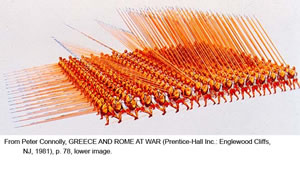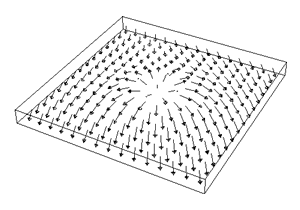Home Quantum Rings Nanotube TransportElectronic Textures Intro for Majors Grad Stat. Mech. Modern Physics Adv. Solid StatePersonnel Publications Links
|
Electronic Textures:
 Imagine a phalanx of spear carrying soldiers. As they march into battle they want to stab the enemy, not their comrades! Thus they all hold their spears nearly parallel, with those in the front line tilting forward. They can't vary the the angle with which they hold their spear appreciably from their neighbor. Imagine a phalanx of spear carrying soldiers. As they march into battle they want to stab the enemy, not their comrades! Thus they all hold their spears nearly parallel, with those in the front line tilting forward. They can't vary the the angle with which they hold their spear appreciably from their neighbor.
 The spin of electrons in two dimensional electron gases acts like the spears above. It is energetically favorable for electrons to allign their spins since electrons with identical quantum numbers cannot spatially overlap, and this minimizes their Coulomb energy. In high magnetic fields, where their motion is quenched, the electron spin field can form textures or bubbles like that shown here (called a skyrmion) that can be described by their topology. The spin of electrons in two dimensional electron gases acts like the spears above. It is energetically favorable for electrons to allign their spins since electrons with identical quantum numbers cannot spatially overlap, and this minimizes their Coulomb energy. In high magnetic fields, where their motion is quenched, the electron spin field can form textures or bubbles like that shown here (called a skyrmion) that can be described by their topology.
Pseuodospin is a generalization of spin to any quantum number that can take on two values, such as the layer index in a double layer system. If a system has both spin and pseudo-spin, the electrons have to point their "spears" in a four dimensional space. In this case there are structures called "CP(3) solitons" that form knots in the electronic texture. These can involve both spin and pseudospin simultaneously.
Publications:
- Theory of Activated Transport in Bilayer Quantum Hall Systems, B. Roostaei, K. J. Mullen, H. A. Fertig, and S. H. Simon, Phys. Rev. Lett. 101, 046804 (2008).
- Pseudospin vortex-antivortex states with interwoven spin textures in double layer quantum Hall systems, J. Bourassa, B. Roostaei, R. Cote, H. A. Fertig and K. Mullen,Phys. Rev. B 74, 195320 (2006).
- Theory of the tunneling resonances of the
bilayer electron systems in strong magnetic field,
R. Khomeriki, M. Abolfath, and K. Mullen,
Phys. Rev. B69, 165321 (2004).
- Goldstone mode kink-solitons in double layer quantum Hall
systems, R. Khomeriki, K. Mullen and S. Revishvilli,
Physica E18, 124 (2003).
|

